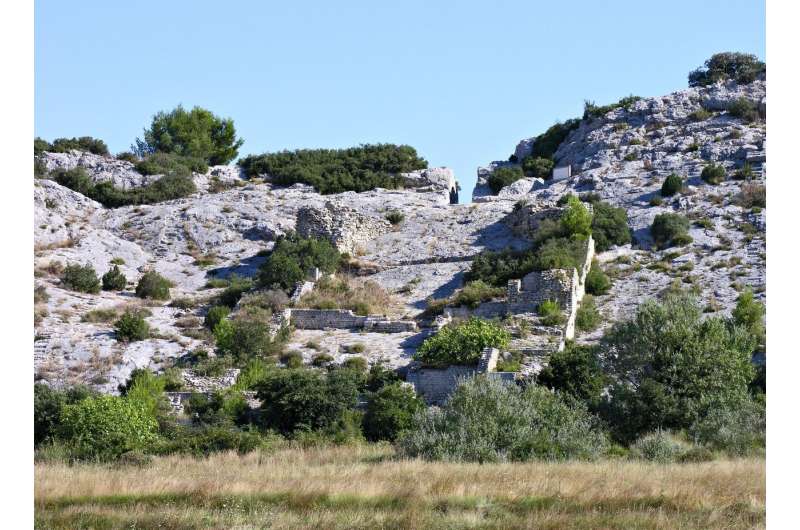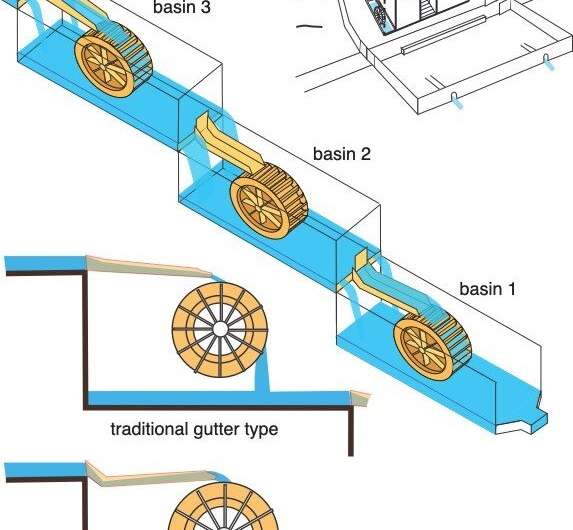View of the ruins of the Barbegal mill complex in 2018. Credit: Robert Fabre, Saint Etienne du Grès, France
The Barbegal watermills in southern France are a unique complex dating back to the second century AD. The construction and its 16 waterwheels represent the first attempt in Europe to build a machine complex on an industrial scale. The complex was created when the Roman Empire was at the height of its power. However, little is known about technological advances, particularly in the field of hydraulics and the spread of knowledge at the time. A team of scientists led by Professor Cees Passchier from Johannes Gutenberg University Mainz (JGU) has now gained new knowledge about the construction and principle of the water supply to the mills in Barbegal. The research results were published in Scientific Reports.
Watermills were one of the first sources of energy that did not depend on the muscle strength of humans or animals. In the Roman Empire, water-powered production was used to make flour and cut stone and wood. As one of the first industrial complexes in European history, the Barbegal watermills are an outstanding example of the development at that time. The mill complex consisted of 16 water wheels in a parallel arrangement of eight wheels each, separated by central buildings and fed by an aqueduct. The upper parts of the complex were destroyed and no traces of the wooden structures have been preserved, which is why the type of mill wheels and how they worked remained a mystery for a long time.
However, carbonate deposits that had formed from the flowing water on the wooden components remained. These were stored in the archeological museum in Arles and only recently examined in detail. The researchers found an imprint of an unusual, elbow-shaped flume that must have been part of the mill construction.
"We combined measurements of the water basins with hydraulic calculations and were able to show that the flume to which this elbow-shaped piece belonged very likely supplied the mill wheels in the lower basins of the complex with water," said Professor Cees Passchier. "The shape of this flume was unknown from other watermills, either from Roman or more recent times. We were therefore puzzled as to why the flume was designed this way and what it was used for."
Carbonate deposits from the side wall of the elbow-shaped water flume, which have formed on the inside of the wooden flume. The vertical patterns are imprints of saw marks on the wood. Credit: Cees Passchier
An elbow-shaped flume as a unique adaptation for the Barbegal mills
At first glance, the team considered such a flume unnecessary and even disadvantageous, because it shortens the height from which the water falls onto the mill wheel. "However, our calculations show that the oddly shaped flume is a unique adaptation for the Barbegal mills," explained Passchier. The distribution of the carbonate deposits in the elbow-shaped flume shows that it was inclined slightly backwards against the direction of the current. This created a maximum flow rate in the first, steep leg of the flume, and at the same time, the water jet to the mill wheel obtained the correct angle and speed. In the complicated mill system, with small water basins, this unique solution was more efficient a traditional, straight water channel. "That shows us the ingenuity of the Roman engineers who built the complex," said Passchier.
"Another discovery was that the wood of the flume was probably cut with a mechanical, water-powered saw, which is possibly the first documented mechanical wood saw—again, evidence of industrial activity in ancient times." The research was carried out by a multidisciplinary team of experts in geology, geochemistry, hydraulics, dendrochronology and archeology.
Sketch of the Barbegal mill complex with the lower three water basins with mill wheels and water flumes: The lower basins most probably had elbow-shaped flumes. Credit: Cees Passchier
The carbonate deposits that formed on the ancient hydraulic structures are an important tool for the researchers for archeological reconstructions. In an earlier project, the team led by Professor Cees Passchier was able to show that the flour from the Barbegal mills was probably used to make ship biscuits. "The carbonate deposits give us extremely exciting insights into the skills of Roman technicians at a time that can be seen as the direct predecessor of our civilization," added Passchier, professor of tectonic physics and structural geology at the JGU Institute of Geosciences from 1993 to 2019, now senior research professor in geoarcheology.
More information: Cees W. Passchier et al, Reconstructing the hydraulics of the world's first industrial complex, the second century CE Barbegal watermills, France, Scientific Reports (2020). DOI: 10.1038/s41598-020-74900-5
Journal information: Scientific Reports
Provided by Universitaet Mainz

























